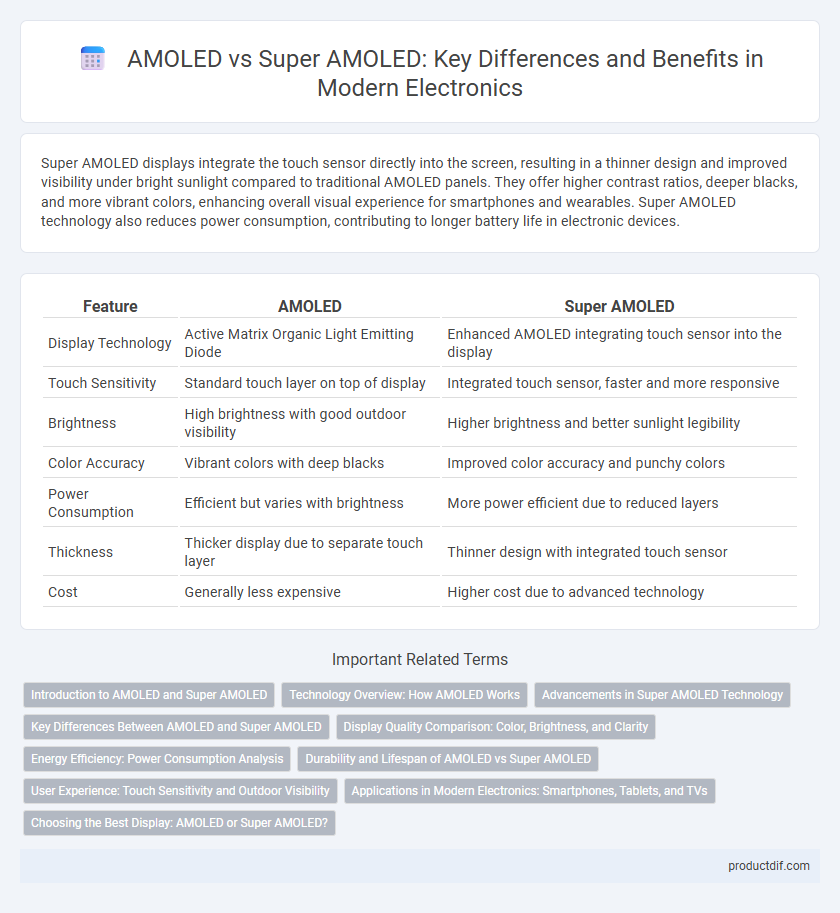Super AMOLED displays integrate the touch sensor directly into the screen, resulting in a thinner design and improved visibility under bright sunlight compared to traditional AMOLED panels. They offer higher contrast ratios, deeper blacks, and more vibrant colors, enhancing overall visual experience for smartphones and wearables. Super AMOLED technology also reduces power consumption, contributing to longer battery life in electronic devices.
Table of Comparison
| Feature | AMOLED | Super AMOLED |
|---|---|---|
| Display Technology | Active Matrix Organic Light Emitting Diode | Enhanced AMOLED integrating touch sensor into the display |
| Touch Sensitivity | Standard touch layer on top of display | Integrated touch sensor, faster and more responsive |
| Brightness | High brightness with good outdoor visibility | Higher brightness and better sunlight legibility |
| Color Accuracy | Vibrant colors with deep blacks | Improved color accuracy and punchy colors |
| Power Consumption | Efficient but varies with brightness | More power efficient due to reduced layers |
| Thickness | Thicker display due to separate touch layer | Thinner design with integrated touch sensor |
| Cost | Generally less expensive | Higher cost due to advanced technology |
Introduction to AMOLED and Super AMOLED
AMOLED (Active Matrix Organic Light Emitting Diode) displays utilize organic compounds that emit light when an electric current passes through, offering vibrant colors and deep blacks with energy efficiency. Super AMOLED integrates the touch sensor directly into the display layer, reducing thickness and enhancing sunlight visibility with quicker touch response. Both technologies are widely used in smartphones, with Super AMOLED providing improved brightness and sharper visuals compared to standard AMOLED.
Technology Overview: How AMOLED Works
AMOLED (Active Matrix Organic Light Emitting Diode) technology uses an active matrix of OLED pixels controlled by a thin-film transistor (TFT) array, allowing each pixel to emit its own light independently, resulting in vibrant colors and deep blacks. Super AMOLED integrates the touch sensors directly into the display, reducing the screen's thickness and improving sunlight readability by minimizing reflections. This integration enhances display responsiveness and energy efficiency compared to traditional AMOLED screens.
Advancements in Super AMOLED Technology
Super AMOLED technology integrates touch sensors directly into the display panel, reducing the screen's thickness and enhancing touch responsiveness compared to traditional AMOLED screens. It offers improved outdoor visibility through better sunlight resistance and higher contrast ratios, achieved by minimizing reflections and increasing pixel density. Enhanced power efficiency in Super AMOLED displays contributes to longer battery life, making it a preferred choice for high-end smartphones and wearable devices.
Key Differences Between AMOLED and Super AMOLED
AMOLED displays feature a thin-film transistor (TFT) backplane with organic light-emitting diodes, providing vibrant colors and high contrast ratios. Super AMOLED integrates the touch sensor directly into the display panel, resulting in thinner screens, improved sunlight visibility, and reduced power consumption compared to standard AMOLED. This integration also enhances responsiveness and outdoor readability, making Super AMOLED a preferred choice for premium smartphones.
Display Quality Comparison: Color, Brightness, and Clarity
Super AMOLED displays offer superior color accuracy and vibrancy compared to traditional AMOLED panels, delivering deeper blacks and more vivid hues due to their integrated touch sensor layer. Brightness levels in Super AMOLED screens are typically higher, enhancing outdoor visibility even under direct sunlight, while maintaining energy efficiency. Clarity benefits from reduced reflectance and improved pixel density, resulting in sharper images and smoother text rendering.
Energy Efficiency: Power Consumption Analysis
Super AMOLED displays integrate the touch sensor directly into the screen, reducing layers and improving energy efficiency by up to 20% compared to traditional AMOLED panels. This power consumption advantage stems from enhanced light transmission and reduced reliance on a separate touch layer, leading to lower battery drain during high brightness and outdoor usage. In practical terms, devices with Super AMOLED screens maintain longer battery life while delivering superior display performance under varied lighting conditions.
Durability and Lifespan of AMOLED vs Super AMOLED
Super AMOLED displays integrate the touch sensors directly into the screen, resulting in improved durability compared to traditional AMOLED panels that have a separate touch layer. The encapsulation technology in Super AMOLED enhances resistance to moisture and dust, extending the lifespan of the display under various environmental conditions. AMOLED screens tend to have shorter lifespans due to their susceptibility to screen burn-in and degradation of organic materials, whereas Super AMOLED technology improves longevity by optimizing display layers and reducing power consumption.
User Experience: Touch Sensitivity and Outdoor Visibility
Super AMOLED displays integrate the touch sensor directly into the screen, resulting in faster and more accurate touch response compared to traditional AMOLED panels with separate touch layers. Enhanced outdoor visibility in Super AMOLED screens is achieved through reduced screen reflections and higher brightness levels, offering clearer visuals under sunlight. Users benefit from improved responsiveness and better readability, elevating the overall interaction quality with mobile devices in various lighting conditions.
Applications in Modern Electronics: Smartphones, Tablets, and TVs
AMOLED displays offer vibrant colors and deep blacks, making them ideal for high-end smartphones and tablets, while Super AMOLED integrates touch sensors directly into the screen for enhanced responsiveness and reduced thickness. Super AMOLED technology is widely used in flagship smartphones, providing better outdoor visibility and lower power consumption compared to standard AMOLED panels. In modern TVs, AMOLED is preferred for its superior contrast ratios and wide viewing angles, though Super AMOLED remains dominant in handheld devices due to its compact design and touch performance.
Choosing the Best Display: AMOLED or Super AMOLED?
Super AMOLED displays integrate the touch sensor directly into the screen, reducing thickness and improving sunlight visibility by up to 20% compared to standard AMOLED panels. AMOLED technology offers vibrant colors and deep blacks through individual pixel illumination, ensuring high contrast ratios essential for immersive viewing experiences. Choosing between AMOLED and Super AMOLED depends on priorities like display brightness, energy efficiency, and outdoor readability, with Super AMOLED often favored for enhanced brightness and reduced glare.
AMOLED vs Super AMOLED Infographic

 productdif.com
productdif.com